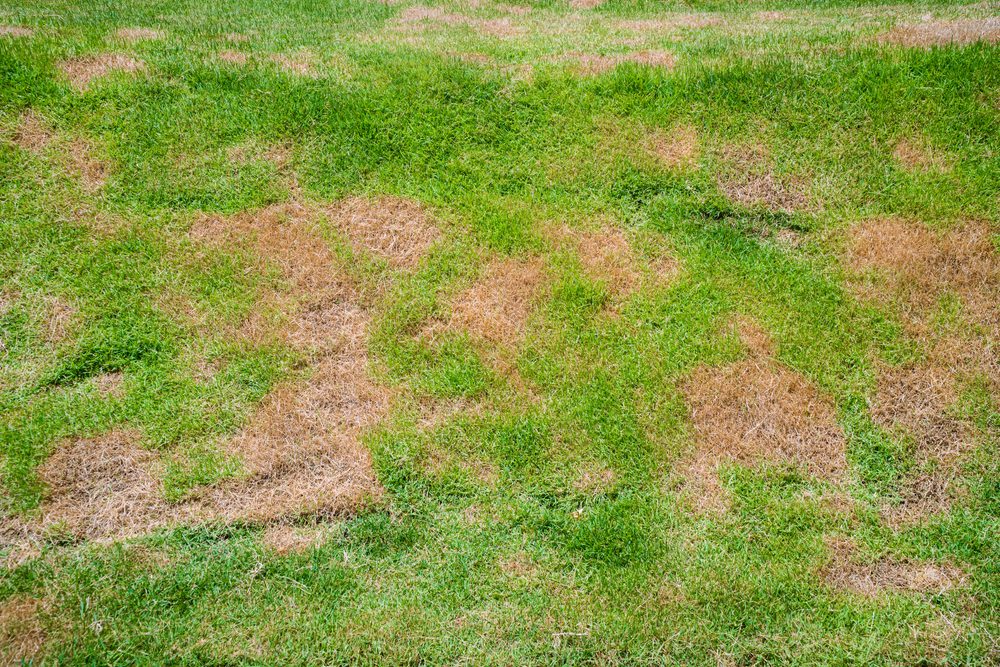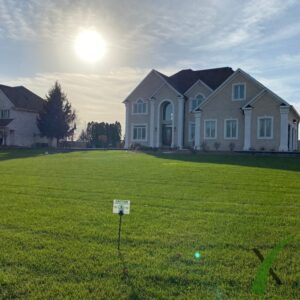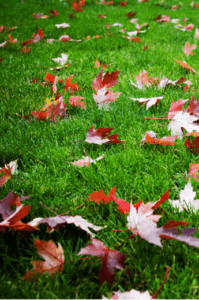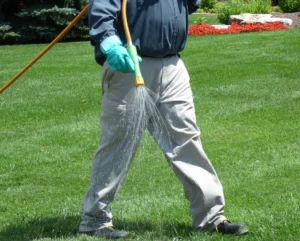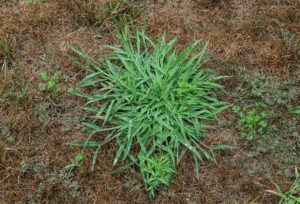Do you want to enjoy your summer in your outdoor space but your lawn is looking a little brown and dry? Wondering how to revive a dead lawn? Do not worry, your lawn can still be saved! No lawn is too far gone, and even dead lawns can be brought back to life with just a few easy steps.
This post by ExperiGreen will go over how to tell the difference between dormant grass and dead grass, how to revive dead grass, and answer some frequently asked questions about how to care for your lawn and keep it vibrant and green.
How to Tell if Your Grass is Dormant or Dead
If you see brown grass in your lawn, that does not necessarily mean that your lawn is dead. Turf grass can actually become dormant if there are poor growing conditions and appear brown on the top. The first step in making your grass green again is to check if your grass is completely dead or if it is just dormant.
Dead Grass
At-home tests will yield different results if your lawn is truly dead. If you inspect the roots and the base of your grass and it looks brown all the way down, then your lawn is dead. Dead grass will also come out easily if you pull on it, and it may even come out in scraggly clumps with dead roots.
Dormant Grass
There are a couple of tests you can do at home to check if your lawn is dormant or dead. For starters, a dormant lawn will brown on the top but the roots will still be green. You can carefully push back your grass and inspect the roots, and if your grass still looks green at the base then it is simply dormant. You can also check for dormant grass by giving it a good tug. If your lawn still feels sturdy and solid, then it is just dormant.
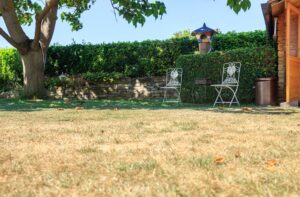
Note: A good sign that you’re dealing with dormant grass is when your lawn turns brown evenly around the same time. Dead grass is usually more patchy.
Can Dead or Brown Grass Turn Green Again?
Depending on if your lawn is dormant or dead, it can potentially turn green again. If your grass is dormant, then it can be revived by improving the growing conditions. This can include watering your lawn if you live in a drier climate or adding fertilizer if your soil is lacking in nutrients.
Unfortunately, if your lawn is truly dead, then it cannot be revived or turned green again. However, there are options to regrow your lawn from square one so you can still enjoy a green outdoor space. One option could be to reseed your lawn and use a fertilizer treatment along with watering it to grow a whole new lawn. Another option could be to install new grass and maintain it to ensure it stays green.
How to Revive Dead Grass
If your grass is looking a little worse for wear, there are a few tips and tricks you can try to revive your lawn and have it back to looking full and green. A few of these methods can be done at home, while others may need a little extra help from a lawn care expert. Some of these treatment options include dethatching your lawn, aerating it, overseeding, and watering your lawn alongside a fertilizer treatment.
Dethatch
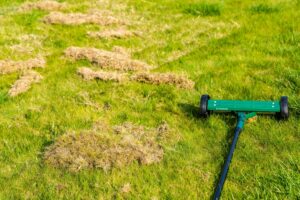
Thatch refers to a layer of living and dead plant material that builds up on the top layer of your soil. While some of this is good for growing strong grass and providing structure for your soil, too much thatch can prevent water and fertilizer from soaking into the soil. It can also contribute to the development of lawn diseases and insect infestations.
Dethatching your lawn can help reset a brown lawn and prepare the soil for new seeds and lawn growth. You can dethatch your lawn manually with a rake, or a lawn care professional can use a specific dethatching mower that will do the hard work for you. These work by essentially tilling the soil and getting rid of that layer of thatch on top of your soil.
Aerate

Aerating your lawn consists of poking a bunch of tiny holes in your yard to allow for better airflow to the soil and improved water circulation. This is typically done when your soil is dense and compact enough that it is difficult for water and nutrients to soak into the soil, leading to a sparse lawn with short roots. Aeration can allow more water, oxygen, and nutrients to go deeper into the soil and encourage more grass growth.
You can aerate your lawn with a manual aerator or an aeration machine that looks similar to a lawn mower. If you can stick a knife into your soil using only your thumb, then your soil is not too dense and you do not need to aerate.
Overseed
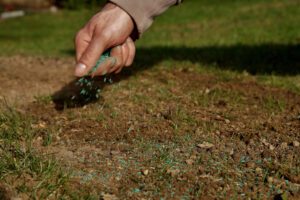
Overseeding consists of sowing a new layer of grass seed over the top of your current lawn to improve lawn density and fill in any patchy areas of your grass. As long as 50% of your lawn is still alive, you can revive the rest of your lawn by overseeding. Be sure to use a grass seed that is native to your area and is well-suited for your climate. You can use a seed spreader to give an even distribution of the seed and consistent lawn growth.
Water & Fertilize
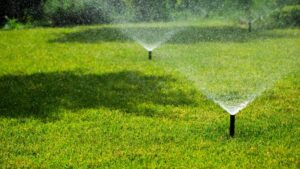
One of the most common causes of a brown lawn is a lack of water, especially in drier climates. Sometimes all your lawn needs is a drink of water to spring back. It can also help to routinely fertilize your lawn and then water shortly after to improve the nutrients in your soil and encourage more grass growth.
Why is My Grass Dead Even Though I Water It?
Are you watering your grass like everyone says to do, yet your lawn still looks like a field of straw? This can be a frustrating situation, but there are a few solutions you can troubleshoot to find the culprit causing your unsightly dead grass. Some of the reasons your lawn may still be scraggly after watering include overwatering, thick thatch, weeds, lawn pests, lawn disease, or too much fertilizer.
- Overwatering: Unfortunately, it is possible to get over-excited about watering your lawn and end up harming your lawn instead. However, there is an easy fix! If you notice your lawn has some standing water or seems too damp, stop watering it for a while and let it completely dry out.
- Thick Thatch: As previously mentioned, if the thatch of your lawn is too thick it can lead to a patchy or sparse lawn. You can either dethatch your lawn manually or with a thatch mower.
- Weeds: Weeds love to infest your lawn and take nutrients and water away from your grass, causing it to become patchy and brown. Removing any weeds you find can help improve the overall health of your lawn.
- Lawn Pests: Lawn pests can include insects such as grubs or ants, and infestations of bugs can damage your lawn and lead to patchy spots.
- Lawn Disease: Diseases such as fungus growths and spores can damage your lawn and cause brown and scraggly patches. A professional lawn care service can treat lawn diseases and help your lawn bounce back from an infection.
- Too Much Fertilizer: Too much of anything can be a problem, and that goes for fertilizer as well. Excessive fertilization of your lawn can kill your grass and lead to patchy areas.
Tips & Insights: Why are There Brown Patches in My Lawn?
FAQs For Reviving Dead Grass
Will watering dead grass bring it back to life?
Unfortunately, if your lawn is dead and not dormant, no amount of watering is going to bring it back to life. You do have other options though, including reseeding your lawn or purchasing new turf to start over with new grass.
How long does it take to revive a dead lawn?
If your lawn is truly dead and not dormant, then there is no way to bring it back without reseeding or buying new turf. If it is dormant, then it will take about a month to revive with the proper care and maintenance.
When is the best time to revive dead grass?
The best time of year to revive dead grass is either in the early fall or late spring. Temperatures are more moderate and there is more moisture for seeds to take root or for sod or turf to establish itself.
Does fertilizer revive dead grass?
Fertilizer is great for bulking up an already healthy lawn or patching up some sparse areas, but it will not bring back an already dead lawn. You should use fertilizer while your lawn is still actively growing to encourage stronger growth.
Should you mow dead grass?
If your lawn looks brown and you are not sure if it is dead or dormant, avoid mowing it. If it is dead, then there is no point as the grass will not grow. If your lawn is dormant, then mowing it will just weaken the grass and risk more damage.
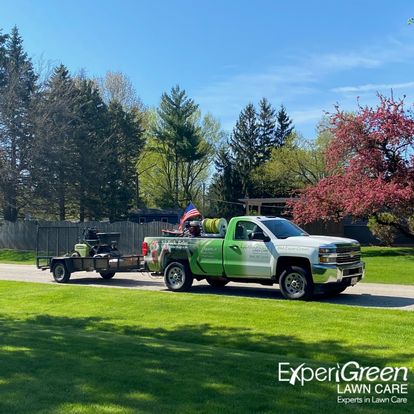
Our Lawn Care Experts Are Here to Help Revive Your Dead Lawn
Looking to schedule a visit with a lawn care specialist and get your lawn back in tip-top shape? Contact ExperiGreen today online or over the phone at 844-349-5070. Our team of experts is ready to get our hands dirty and help you make your lawn lush and green again!

